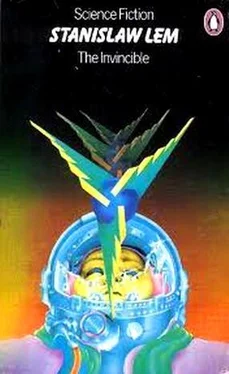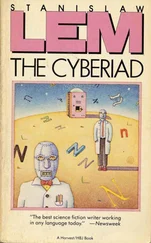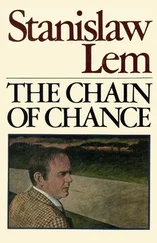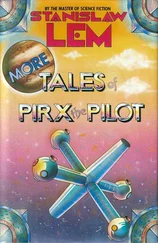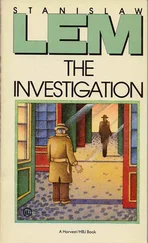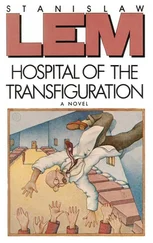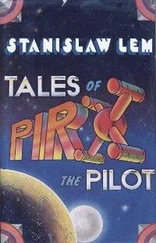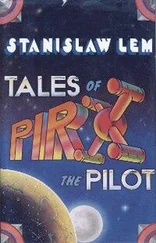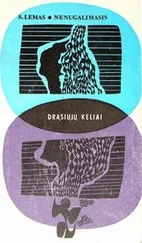Resolutely, Rohan made an about-face and walked away. For quite some time, however, he could hear the tumult on the boulder hill and the repeated metallic dragging of feet, a sound that was tossed back and forth many times between the facing rocky slopes, a multiple echo. He made good headway now, since the path he had taken — over the flat stones in the dry brook — was fairly smooth and descended gently. Nothing was to be seen of the cloud; only an occasional trembling of the air above the slopes gave away the simmering in the black thicket. By now he had arrived at the widest part of the gorge, which opened into a basin, framed by rocky heights. He was roughly a mile and a half from the rock gate, where the catastrophe had occurred. Only now did he realize how hard it would be without an olfactometer, which could have helped him find human traces; but the instrument was much too heavy to be carried on foot. He would just have to get along without it. He stopped and examined the rocky walls. No one could possibly have taken refuge in the metal thicket. That left only the grottoes, caves and hollows in the rocks — he counted several from where he was standing. High rock shelves with vertical faces, that presented extraordinary difficulties for the climber, hid the caves’ interiors from sight, and he decided to begin by examining the grottoes, one after the other. Back aboard the spacecruiser, he had tried, together with the psychologists and the physicians, to figure out where he should search for the four lost men — in other words, where they were most likely to be hiding. But in reality the conference had been of little use, since the behavior of an amnesiac was unpredictable. The fact that the lost men had been together when they left the rest of Regnar’s group indicated that some kind of activity set them off from the others. And to a certain extent, the fact that the trails of the four men had not separated once at any point along the terrain explored so far, justified the hope of finding all four together in the same area — only if they were still alive, naturally, and had not spread out in various directions above the rock gate. Rohan made a thorough search in two smaller and four larger grottoes, one after the other, which he could enter fairly easily since he needed only to climb over a few large, slanting rock shelves. This was not dangerous and took only a few minutes. In the last grotto he stumbled on metal debris, partly covered with water. At first he believed it to be the skeleton of the second Arctane; but they were extremely old and unlike any design he had ever encountered before. In a shallow puddle of water, which was visible because the smooth, almost polished vaulted ceiling of the grotto reflected some sparse daylight, he saw an elongated form, something like a fifteen-foot-long cross. The outer metal hull had long since fallen apart, disintegrated, mixed with the muddy ground and now formed a rust-red mass. Rohan could not indulge in a closer examination of this unusual find, perhaps the wreck of one of the macro-automats that had been exterminated by the fittest of the inorganic evolution, the black cloud. All he could permit himself was to fix the image on his mind: hazy outlines of braces and poles which probably were used for flying rather than for walking. A glance at his watch urged him to hurry on, and without further delay he continued to search through the next caves. But they were so numerous — from the bottom of the ravine they peered out occasionally like dark yawning windows in the steep rock walls — and the often flooded subterranean corridors that sometimes led into straight-walled, vertical tunnels and ditches with icy, gurgling rivulets, were so tortuous that he did not dare penetrate too deeply into them. Besides, he carried only a small flashlight which provided relatively weak illumination and was especially powerless inside the more spacious grottoes with their tall, vaulted ceilings and innumerable galleries. Finally, totally exhausted and near collapse, he sat down on a huge flat sun-warmed boulder near the exit of a cave he had just finished examining, and chewed a few bars of the food concentrate, washing the dry mouthfuls down with some water from the little brook. Several times he thought he heard the rustling of the approaching cloud but it was probably just the echo from the Sisyphus-like labors of the Arctane reverberating from the upper regions of the ravine. After he had finished eating his meager provisions, he felt much better. What surprised him most was the realization that he was less and less worried about his dangerous surroundings, the black thicket that extended over all the slopes, wherever he looked.
He climbed down the rocky promontory in front of the cave after resting there for a while, and perceived a thin, rusty streak that extended across the dry stones to the opposite side of the gorge floor. As he reached the spot, he saw that they were traces of blood. They had dried completely and faded, and had it not been for the unusually bright white color of the limestone-like rocks, he would most likely have missed the tracks. He tried to determine which direction the wounded man must have taken, but it was hopeless. So he marched up the valley arbitrarily, driven by the thought that the blood must have come from someone who was wounded during the battle between the Cyclops and the cloud, someone who had tried to leave the battle scene. The tracks intersected and broke off in places, but eventually they led him toward a cave which was one of the first he had searched before. He was all the more astonished when — directly by the entrance to the cave — a vertical, shaft-like narrow cleft opened, which he had failed to notice earlier. The blood ended there. Rohan kneeled down and bent over the shadowy hole in the ground. Although he had been prepared for the worst, he could not suppress a stifled cry when he saw Benningsen’s head staring at him with empty eye sockets and bared teeth. He recognized the man by his gold-rimmed glasses, whose lenses had remained undamaged by some fluke of fate and now sparkeled brightly in the light reflected from the limestone slab that tilted over the stone coffin. The geologist was wedged between boulders, his shoulders jammed into the natural lining of the rocky shaft, so that his body had remained upright. Rohan did not want to leave the man’s remains behind, but when he gathered up his courage and tried to lift the body, through the thick material of the protective suit he could feel the corpse disintegrating under his touch. Decay had already done its work, accelerated by the effect of the sunrays that penetrated this spot every day. Rohan finally zipped open the breast pocket in Benningsen’s suit and removed the scientist’s dog tag. Before moving on, he gathered up his last ounce of strength and rolled one of the nearest rock slabs toward the shaft to seal the rocky tomb.
The first man had been found. Not until Rohan was a good distance away did it occur to him that he ought to have tested the corpse for radioactivity, for the degree of contamination might shed some light on the fate that had befallen the geologist and his friends. A high radioactive count would have proved that the dead man had been near the scene of the atomic battle. But he had forgotten to make the test, and nothing could have induced him to roll the coffin’s stone lid aside again. At the same time, Rohan became aware how important a role chance was playing during his endeavors, for he had undoubtedly made a thorough search all around this spot when he had first been there.
Inspired by a new thought, he now hastily pursued the blood trail in order to find its beginning. The trail led almost in a straight line down into the valley, in the direction of the atomic battlefield. But after just a few hundred paces, the trail made a sudden turn. The geologist had lost a great deal of blood; thus it was all the more surprising that he should have come so far. The stones, which had not been touched by a single drop of rain since the catastrophe, were covered with blood. Rohan climbed some large wobbly boulders and found himself in a spacious, basin-like trough below a barren cliff. The first thing he saw was the huge metal sole of a robot. It lay on its side, evidently split down the middle by a Weyr gun. Off to the side, farther down, a man was leaning against a stone in a half-seated position, his body almost folded over in two halves; his helmet was blackened by soot. The man was dead. The Weyr gun still dangled from his limp hand, its glittering barrel touching the ground. Rohan did not immediately dare to touch the man; instead, he knelt next to him and tried to look into his face, but it was just as disfigured by decay as Benningsen’s had been. Just then he discovered the broad, flat satchel of the geologist hanging over the shrunken shoulder of the corpse. It was Regnar himself, the leader of the expedition that had been attacked in the crater. According to the radioactivity readings, the Arctane had been wrecked by the charge of a Weyr gun: the indicator registered the characteristic isotopes of rare earth. Rohan wanted to remove Regnar’s dog tag but he could not bring himself to do it. He simply unbuckled the satchel, so that he did not have to touch the corpse.
Читать дальше
